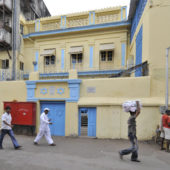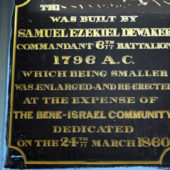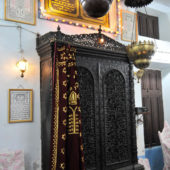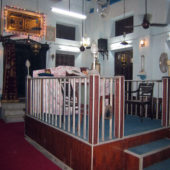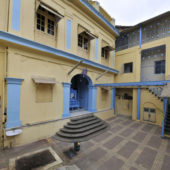A Bnei Israel man, 6th Battalion Commandant Samuel Ezekiel Dewaker, built Shaar Harachamim in 1796. Dewaker was taken prisoner by Muslims and took an oath that if he would be freed he would build a shul. He kept his promise and the shul was built shortly after he returned to Mumbai. It was enlarged and remodeled in 1860.
Shaar Harahamim is a Synagogue with an unusual history, which testifies to faith. The culture, Orthodox traditions and faith of the Bene Israel Jewish people are kept alive by this vibrant congregation.
For centuries, Jews in India met and prayed together in temporary structures or community members’ homes. The buildings that were eventually built vary significantly in terms of size, style, and overall appearance. Bene Israel Jews, a group of immigrants from the west who settled in Mombai and Pune in the late 18th century and early 19th century, are the largest of the three groups of Indian Jews. They constructed synagogues of various styles, including Art Deco and Colonial influences. The Shaar Harahamim Synagogue is a Ben Israel synagogue.
“Shaar Harahamim” translated, “Gate of Mercy” Synagogue, is Mumbai’s oldest synagogue. The story behind this Synagogue is that until the 18th century, the Bene Israel Jews, located in the western region of the city, did not have a synagogue in which to pray. In the summer of May 1796, the Late Commandant Samaji Hasaji Divekar (Samuel Ezekiel Divekar) and his brother served as officers in the 6th Battalion of the British East Indian Army. They were captured by Mysore king Tipu Sultan and asked what caste they belonged to. The Sultan’s wife had sympathy for the Divekars’ caste and eventually their lives were exchanged for a prisoner held by the British. Samuel Divekar resolved to build a synagogue to God if he survived. In gratefulness to God for sparing his life, Samuel Divekar and his brother pioneered the construction of Shaar Harahamim. In 1860, the Synagogue was rebuilt and moved to its present location at Mandvi. On April 2, 1919, the Synagogue members arranged a meeting of Bene Israeli regarding Zionism. Over 350 people attended the meeting and it was decided that they would set up an independent homeland of Palestine.
The exterior of the façade is plain stuccowork painted yellow, with light blue painted trim. Inside, the interior is Colonial style, with white walls which are offset by very dark woodwork in the paned windows, benches, and Aron-Kodesh. The ceiling is painted with simple blue designs, a simple drop chandelier in the center of the bimah, and multiple dark metal drop lights. At the east end of the prayer-room is the Aron-Kodesh, which is enclosed in a dark wood wardrobe-type of enclosure, which is intricately carved and gilded with gold. Two tablets with The Ten Commandments inscribed in Hebrew are placed on the wall above the Aron-Kodesh. In the middle of the sanctuary, sits the tivah (reader’s desk) on a raised platform of dark wood, with a dark wood balustraude surrounding it. There is an upstairs balcony of dark wood, in the back of the prayer-room. Shaar Harahamim can seat 300 people. There is a mikvah (ritual bath) nearby.
The synagogue continues to serve approximately 100 members for daily services, as well as weekly Shabat and High Holiday services. It is also featured on heritage and religious tours of the city.
Shaar Harahamim is a Synagogue that was conceived in thanksgiving to God. There continues to be an active congregation over a century later, who testify to the faith, traditions and culture of the God of Samuel Divekar.

